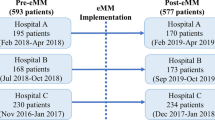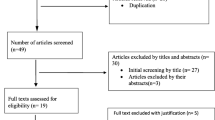Abstract
Objective
Information on the frequency of drug combinations with the potential to induce dangerous drug–drug interactions (DDIs) in patients discharged from the hospital is scarce. With the present study, we assessed the frequency and potential clinical significance of DDIs in the prescriptions of discharged medical patients.
Methods
We retrospectively screened the medication for potential DDIs of 500 patients consecutively discharged with at least two prescriptions using a computerised drug-interaction program.
Results
The 500 patients (56.6% male, mean age 67.0±15.9 years, median length of stay 13 days) were prescribed a median of six drugs (range 2–18) at discharge. Three hundred patients (60.0%; 95% confidence interval 55.7–64.3%) had at least one potentially interacting drug combination. Of 747 potential DDIs at discharge overall, 402 (53.8%) were new at the time of discharge due to a change of the medication during the hospital stay. Of these, 72 (17.9%) were of potentially minor, 281 (69.9%) of moderate and 49 (12.2%) of major severity. Of 44 patients with a potential DDI with major severity, 1 patient was re-hospitalised within 2 months after discharge due to a probable drug-related problem associated with the potential DDI.
Conclusions
Using a computerised drug-interaction program, a high proportion of patients was detected with at least one potential DDI in the medication prescribed at discharge. However, the proportion of DDIs associated with potentially relevant clinical consequences appeared to be relatively low.
Similar content being viewed by others
References
Gosney M, Tallis R (1984) Prescription of contraindicated and interacting drugs in elderly patients admitted to hospital. Lancet 2:564–567
Mitchell GW, Stanaszek WF, Nichols NB (1979) Documenting drug–drug interactions in ambulatory patients. Am J Hosp Pharm 36:653–657
Schneider JK, Mion LC, Frengley JD (1992) Adverse drug reactions in an elderly outpatient population. Am J Hosp Pharm 49:90–96
Manchon ND, Bercoff E, Lemarchand P, Chassagne P, Senant J, Bourreille J (1989) Fréquence et gravité des interactions médicamenteuses dans une population agée: étude prospective concernant 639 malades. Rev Med Interne 10:521–525
Costa AJ (1991) Potential drug interactions in an ambulatory geriatric population. Fam Pract 8:234–236
Shinn AF, Shrewsbury RP, Anderson KW (1983) Development of a computerized drug interaction database (MEDICOM) for use in a patient specific environment. Drug Inf J 17:205–210
Jankel CA, Fitterman LK (1993) Epidemiology of drug–drug interactions as a cause of hospital admissions. Drug Saf 9:51–59
Raschetti R, Morgutti M, Menniti-Ippolito F, Belisari A, Rossignoli A, Longhini P et al (1999) Suspected adverse drug events requiring emergency department visits or hospital admissions. Eur J Clin Pharmacol 54:959–963
Heininger-Rothbucher D, Bischinger S, Ulmer H, Pechlaner C, Speer G, Wiedermann CJ (2001) Incidence and risk of potential adverse drug interactions in the emergency room. Resuscitation 49:283–288
Herr RD, Caravati EM, Tyler LS, Iorg E, Linscott MS (1992) Prospective evaluation of adverse drug interactions in the emergency department. Ann Emerg Med 21:1331–1336
Wiesner C, Hersberger KE, Surber C, Haefeli WE (1999) Drug safety after hospital discharge. Pharm World Sci 22:A18
Grönroos PE, Irjala KM, Huupponen RK, Scheinin H, Forsstrom J, Forsstrom JJ (1997) A medication database—a tool for detecting drug interactions in hospital. Eur J Clin Pharmacol 53:13–17
Beers MH, Storrie M, Lee G (1990) Potential adverse drug interactions in the emergency room. An issue in the quality of care. Ann Intern Med 112:61–64
Wiltink EH (1998) Medication control in hospitals: a practical approach to the problem of drug–drug interactions. Pharm World Sci 20:173–177
Bonetti PO, Hartmann K, Kuhn M, Reinhart WH, Wieland T (2000) Potentielle Arzneimittelinteraktionen und Verordnungshäufigkeit von Medikamenten mit speziellem Instruktionsbedarf bei Spitalaustritt. Schweiz Rundsch Med Prax 89:182–189
Di Castri A, Jacquot JM, Hemmi P, Moati L, Rouy JM, Compan B et al (1995) Intéractions médicamenteuses: etudes de 409 ordonnances établies à l'issue d'une hospitalisation gériatrique. Therapie 50:259–264
Köhler GI, Bode-Boger SM, Busse R, Hoopmann M, Welte T, Boger RH (2000) Drug–drug interactions in medical patients: effects of in-hospital treatment and relation to multiple drug use. Int J Clin Pharmacol Ther 38:504–513
Kruse W, Kohler J, Oster P, Schlierf G (1988) Potentielle Medikamentenwechselwirkungen in der Behandlung multimorbider Hochbetagter. Z Gerontol 21:164–168
Smith L, McGowan L, Moss-Barclay C, Wheater J, Knass D, Chrystyn H (1997) An investigation of hospital generated pharmaceutical care when patients are discharged home from hospital. Br J Clin Pharmacol 44:163–165
Atkinson AB, Brown JJ, Morton JJ, Leckie B, Fraser R, Lever AF et al (1979) Captopril in a hyponatraemic hypertensive: need for caution in initiating therapy. Lancet 1:557–558
Gluck Z, Beretta-Piccoli C, Reubi FC (1984) Long-term effects of captopril on renal function in hypertensive patients. Eur J Clin Pharmacol 26:315–323
Romero R, Castellote E, Ocon J, Wagner B (1995) Controlled multicenter study with quinapril, hydrochlorothiazide, and combination in patients with moderate to severe hypertension. J Cardiovasc Pharmacol 26:114–118
Nilsen OG, Sellevold OF, Romfo OS, Smedsrud A, Grynne B, Williams PE et al (1989) Pharmacokinetics and effects on renal function following cilazapril and hydrochlorothiazide alone and in combination in healthy subjects and hypertensive patients. Br J Clin Pharmacol 27:323S–328S
Guazzi MD, Campodonico J, Celeste F, Guazzi M, Santambrogio G, Rossi M et al (1998) Antihypertensive efficacy of angiotensin converting enzyme inhibition and aspirin counteraction. Clin Pharmacol Ther 63:79–86
Mahe I, Meune C, Diemer M, Caulin C, Bergmann JF (2001) Interaction between aspirin and ACE inhibitors in patients with heart failure. Drug Saf 24:167–182
Doman K, Perlmutter JA, Muhammedi M, Puschett JB (1993) Life-threatening hyperkalemia associated with captopril administration. South Med J 86:1269–1272
Fuster D, Frey FJ, Ferrari P (2000) Bedrohliche Hyperkaliämie als Folge der neuen Behandlungsstrategien der Herzinsuffizienz. Schweiz Rundsch Med Prax 89:2073–2076
Johnston RT, de Bono DP, Nyman CR (1992) Preventable sudden death in patients receiving angiotensin converting enzyme inhibitors and loop/potassium sparing diuretic combinations. Int J Cardiol 34:213–215
Matthews MK Jr (1998) Association of Ginkgo biloba with intracerebral hemorrhage. Neurology 50:1933–1934
Vale S (1998) Subarachnoid haemorrhage associated with Ginkgo biloba. Lancet 352:36
Rowin J, Lewis SL (1996) Spontaneous bilateral subdural hematomas associated with chronic Ginkgo biloba ingestion. Neurology 46:1775–1776
Roberts JS, Watrous ML, Schulz RM, Mauch RP, Nightengale BS (1996) Quantifying the clinical significance of drug–drug interactions: scaling pharmacists' perceptions of a common interaction classification scheme. Ann Pharmacother 30:926–934
Author information
Authors and Affiliations
Corresponding author
Rights and permissions
About this article
Cite this article
Egger, S.S., Drewe, J. & Schlienger, R.G. Potential drug–drug interactions in the medication of medical patients at hospital discharge. Eur J Clin Pharmacol 58, 773–778 (2003). https://doi.org/10.1007/s00228-002-0557-z
Received:
Accepted:
Published:
Issue Date:
DOI: https://doi.org/10.1007/s00228-002-0557-z




